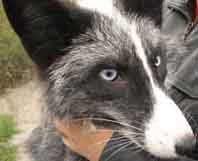Belyaev's Experiment
When Belyaev started experiment, he had no idea what he was doing. This sort of experiment had never been done before. Belyaev was asked by the fox fur traders to help them create a less aggressive fox for them to work with. Belyaev started with foxes that did not trust humans at all. They were aggressive and scared of people most of the time. The video below will show the type of foxes Belyaev had to start with.
Dmitri Belyaev had started with these types of foxes for his experiment. He started his experiment by finding the least aggressive foxes that he could find. This wasn't an easy task. Most of the foxes behaved like the fox in the video above. Out of thousands of silver foxes from fur traders around the Soviet Union, Dmitri picked five hundred foxes that he believed were the least aggressive. He bred those foxes. He picked five hundred of the pups that he felt were the least aggrssive. He kept doing this and he began to see a strange thing occur. By the tenth generation, Dmitri noticed that the foxes didn't look like foxes anymore.
The foxes began to take on dog like features. They began to get blue eyes and floppy ears. Their tail lengths were unpredictable. Sometimes they were long and sometimes they were short. Many of the foxes began to bark. Some of the foxes' coats started to get white stripes in them. Dmitri Belyaev began to get into trouble with the fur traders because the fur traders could not use a fox with a long white strip down its chest or on its tail. Dmitri then discovered what was going on in his foxes.
When Dmitri would pick a fox to breed, he wasn't just picking a docile fox, he was picking a fox with low adrenaline levels. He figured out that these adrenaline levels were linked to how the fox looked. The low adrenaline levels blocked the fight-or-flight response and in turn made them tame. Twenty-five years later, Dmitri saw the first domestic fox. It was extremely tolerant of humans. Dmitri kept breeding the foxes. The genes in the foxes became more and more reliable for low adrenaline levels. The video below illustrates the behavior of the fox after twenty- five years of breeding foxes for tameness.
The two videos show quite a difference in behavior. Both of the foxes in the videos were around people since the day they were born. The fox in the first video was not one of Dmitri Belyaev's foxes. The fox in the second video was one of Dmitri Belyaev's foxes. The second fox is clearly domesticated and has no fear of humans or interactions with humans. Fifty years after Dmitri Belyaev started his experiment, the gene for domestication (low adrenaline levels) became reliable (which means it showed up in every generation). What many scientists thought would take hundreds of years, Dmitri Belyaev did in fifty years. His discovery gave new insight to the domestication of dogs and future domestication of other animals. For the whole experiment, go to http://www.floridalupine.org/publications/PDF/trut-fox-study.pdf

